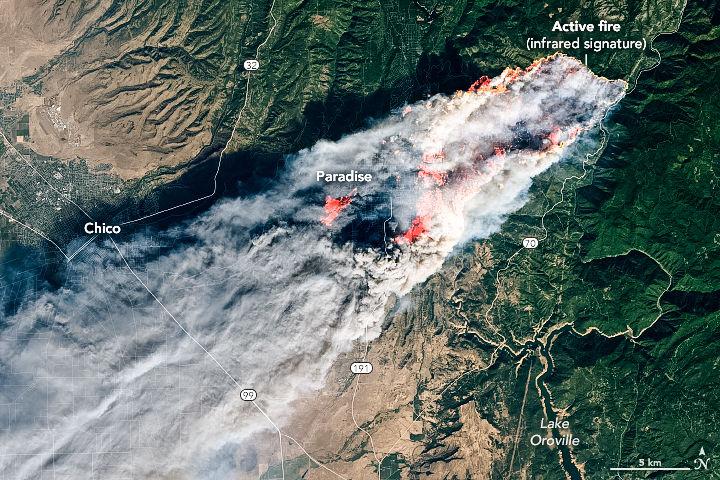The Camp, Nurse, Hill and Woolsey wildfires have raged through 386 square miles of California for over a week, with firefighters consistently working to contain the flames.
At the time of publication, 77 fatalities and 993 missing persons have been reported by authorities. The Camp Fire is the deadliest in state history, reducing the town of Paradise to ash and continuing destruction of other communities on the mountaintop. Twenty-three Texas counties have deployed firefighters to the the Woolsey Fire, 27 of whom are Texas A&M Forest Service personnel.
Jon Keeley, research scientist with the U.S. Geological Survey and adjunct professor at the University of California-Los Angeles, said the source of the fires is currently unknown, but newspapers are speculating it might have been power lines that started the fire in Paradise. Apart from this, Keeley said the dry conditions from drought helped the fire propel itself.
“It’s not unreasonable speculation since the Napa-Sonoma fires of October 2017 were all started by power lines,” Keeley said. “It seems like a good possibility, but we don’t know that at the present time.”
These fires were much worse than others because of the autumn winds in California, Keeley said. Known in northern California as the North Winds and in Southern California as the Santa Ana Winds, these are extreme winds ranging from 50 to 75 mile per hour at five percent relative humidity. These appear during the drought period, which lasts from May to November.
“If somebody lights a fire during those windy conditions, either intentionally or accidentally, you have the setting for a really bad fire,” Keeley said. “In California right now though, one of the reasons they’re so severe has to do with the fact that California has had a really bad drought beginning in 2012.”
Keeley said the town of Paradise did an exercise to see how well prepared they were for fire. There is one road leading in and out of the town, which is located on a ridge in the Sierra-Nevada foothills. Keeley said he doesn’t see a solution.
“It took something like 5 hours to evacuate the whole town,” Keeley said. “When you have fire driven at 70 miles per hour, it’s obvious people aren’t going to get out. There’s some reason to believe that there was some concern ahead of time because of these exercises that they were in peril.”
Keeley said this disaster is not caused by climate change alone but that it is an exacerbating factor. Andrew Dessler, professor of atmospheric sciences at A&M, also said the fires are heightened because of climate change.
“I think the first thing to realize is that climate change doesn’t cause fires any more than steroids hit home runs, but if you give steroids to a baseball player they’ll hit more runs,” Dessler said. “Similarly, forest fires happen naturally, but climate change is changing them in ways that are not good for humans.”
Dessler said he sympathizes with those affected by the wildfires and points out that socioeconomic status may play a role in the ability for recovery. Of the over 39 million people living in California, 13.3 percent of people are in poverty while the average household income is $63,783 according to the census.
“For people that are well off, they’ll probably be able to recover okay, [but] even for them it will be bad,” Dessler said. “Butthe people that are very poor, those are the people who are going to have the most trouble, so it’s another example of these impacts that selectively impact people on the bottom on the socioeconomic ladder.”
Natalie Johnson, assistant professor at A&M in the department of environmental and occupational health in the school of public health, said these wildfires can create smoke that has harmful particles and poses risks similar to breathing in tobacco smoke.
“There’s many studies that show firefighters exposed during work may have reduced lung function,” Johnson said. “However most of the first responders will have adequate respiratory protection and it’s critical that they do wear that so they can ensure they don’t inhale the fine and ultrafine particles.”
Melanie Karns, hazard mitigation coordinator for the A&M Forest Service said the A&M forest service wildfire response team has missions that change on a daily basis. As of Thursday, there were no injuries or fatalities of the A&M Forest Service crew.
“The main thing that Texas A&M Forest Service is contributing to the Woolsey Fire is just assistance in suppression,” Karns said. “What we do as a nation — states assist each other. We have folks from California come out to assist Texas on wildfires as well as all the other states in the United States.”
A&M Forest Service helps fight devastating California wildfires
November 19, 2018
Photo by via NASA.gov
The wildfires raging in California are the deadliest in state history, destroying entire communities and leaving residents with ashes to call home.
0
Donate to The Battalion
$2790
$5000
Contributed
Our Goal
Your donation will support the student journalists of Texas A&M University - College Station. Your contribution will allow us to purchase equipment and cover our annual website hosting costs, in addition to paying freelance staffers for their work, travel costs for coverage and more!
More to Discover










